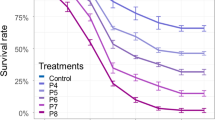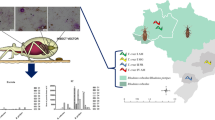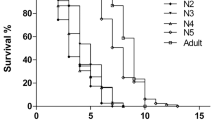Abstract
We recently standardised Mesocestoides vogae (syn. corti) tetrathyridia cultures in the presence of sodium taurocholate. Parasite clustering and segmentation were observed as taurocholate-dependent effects in biphasic and monophasic media, respectively, and both were inhibited by a specific minimum inhibitory concentration (m.i.c.) of the cestocidal drugs albendazol and praziquantel. In the present study, we analysed the relationship between clustering inhibition and drug toxicity using praziquantel and a mouse experimental infection. In an "in vitro–in vivo" trial, a significant (ANOVA, P<0.05) reduction was observed in the infectivity of tetrathyridia previously cultured with praziquantel m.i.c. (0.06 µg/ml) for 10 days. In an "in vivo–in vitro" trial, the clustering of tetrathyridia recovered from mice treated with praziquantel was found to be markedly reduced: 22%, compared with 83% cluster-containing wells of parasites from control mice. These results show that the outcome of infection and the suppression of taurocholate-induced clustering provide consistent indications of praziquantel toxicity against M. vogae, an observation confirmed by histological studies. The easily recorded clustering inhibition of M. vogae tetrathyridia in biphasic medium is a potentially useful system for the assessment of drug toxicity against cestode larvae..




Similar content being viewed by others
References
Andrews P, Thomas H, Pohlke R, Seubert J (1983) Praziquantel. Med Res Rev 3:147–00
Barrett N, Smith J, Ong S (1982) Spontaneous sexual differentiation of Mesocestoides corti tetrathyridia in vitro. Int J Parasitol 12:315–22
Becker B, Mehlhorn H, Andrews P, Thomas H, Eckert J (1980) Ligh and electron microscopic studies on the effect of praziquantel on Schistosoma mansoni, Dicrocelium dendriticum and Fasciola hepatica (Trematoda) in vitro. Z Parasitenkd 63:113–28
Chernin J, Thompson D, Swaine D (2002) In vitro culture of tetrathyridia of Mesocestoides corti using a gel based diphasic medium. J Helminthol 76:21–5
Hrckova G, Velebny S (1997) Effect of liposome-incorporated praziquantel on peritoneal macrophage activation in mice infected with Mesocestoides corti tetrathyridia (Cestoda). Parasitology 114:475–82
Hrckova G, Velebny S, Dezfuli BS (1998) Entrapment of praziquantel in liposomes modifies effects of drug on morphology and motility of Mesocestoides corti (syn. M. vogae, Cestoda) tetrathyridia in mice. Helminthologia 35:13–20
Johnson WJ, Cain GD (1988) The selective uptake of cholesterol by the rat tapeworm Hymenolepis diminuta ((Cestoda). Comp Biochem Physiol 91:51–58
Novak M (1977) Efficacy of a new cesticide, praziquantel, against larval Mesocestoides corti and Taenia crassiceps in mice. J Parasitol 63:949–50
Rausch RL (1995) Life cycle patterns and geographic distribution of Echinococcus species. In: Thompson RCA, Lymbery AJ (eds) Echinococcus and hydatid disease. CAB International, Wallingford, pp 89–134
Saldaña J, Marín M, Fernández C, Domínguez L (2001) In vitro taurocholate-induced segmentation and clustering of Mesocestoides vogae (syn. corti) tetrathyridia (Cestoda)- inhibition by cestocidal drugs. Parasitol Res 87:281–6
Smyth JD, McManus DP (1989) The physiology and biochemistry of cestodes. Cambridge University Press, Cambridge
Thomas H, Gönnert R (1978) The efficacy of praziquantel against experimental cysticercosis and hydatidosis. Z Parasitenkd 55:165–79
Acknowledgements
The Animal Care Committee of the Faculty of Chemistry approved the protocols for the in vivo experiments. These were carried out following the guidelines of the Canadian Council on Animal Care. This work was supported by grants from PEDECIBA (Project URU/97/016) and CSIC (Uruguay). We would like to thank Luis Abad and Marcelo Fernández for careful animal maintenance; Dr Carlos Carmona for the use of histology facilities; and Oxoid Laboratory (UK) for providing the nutrient parasite gel.
Author information
Authors and Affiliations
Corresponding author
Rights and permissions
About this article
Cite this article
Saldaña, J., Casaravilla, C., Marín, M. et al. The toxicity of praziquantel against Mesocestoides vogae (syn. corti) tetrathyridia can be assessed using a novel in vitro system. Parasitol Res 89, 467–472 (2003). https://doi.org/10.1007/s00436-002-0801-6
Received:
Accepted:
Published:
Issue Date:
DOI: https://doi.org/10.1007/s00436-002-0801-6




